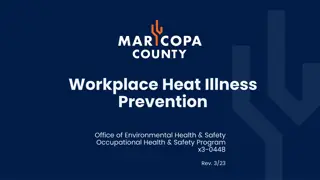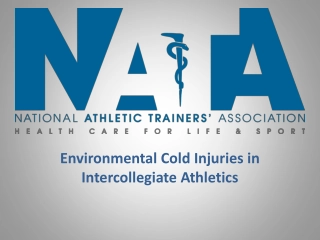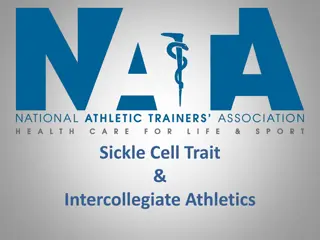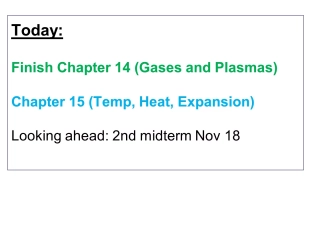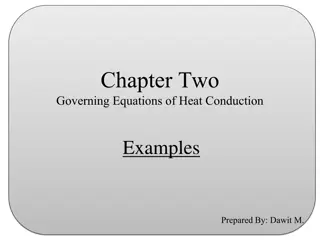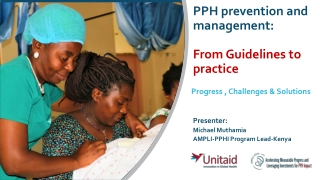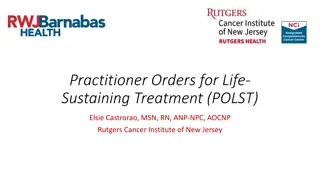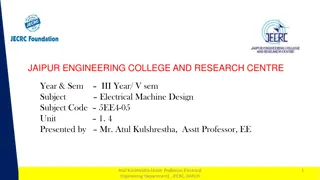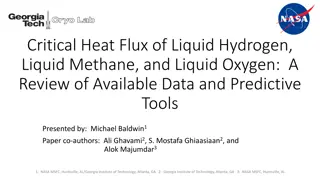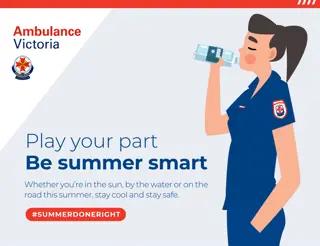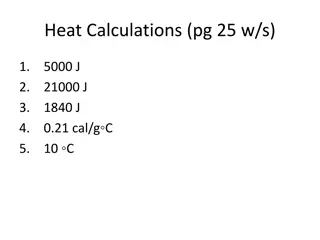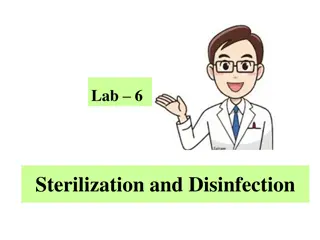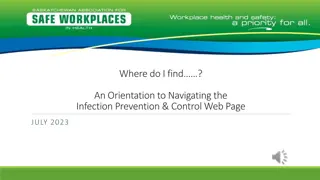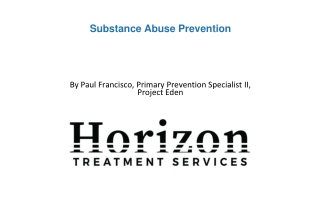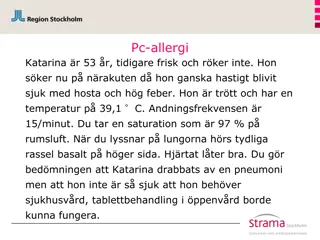Prevention and Treatment of Heat Illness in Intercollegiate Athletics
Learn about exertional heat illness prevention strategies, identification of predisposed athletes, and treatment approaches for heat cramps and heat exhaustion in intercollegiate athletics. Proper hydration, acclimatization, education, and monitoring are crucial for athlete safety during high heat stress conditions.
Download Presentation
Please find below an Image/Link to download the presentation.
The content on the website is provided AS IS for your information and personal use only. It may not be sold, licensed, or shared on other websites without obtaining consent from the author. Download presentation by click this link. If you encounter any issues during the download, it is possible that the publisher has removed the file from their server.
Presentation Transcript
Exertional Heat Illness Prevention Identification of those athletes more predisposed or have previous history (Insert list of particular student-athletes here as needed) Special considerations and modifications are needed for those wearing protective equipment during periods of high heat stress Acclimatize athletes over a period of 7-14 days when possible Educate athletes on prevention, recognition, treatment, risks, and how to pre- hydrate and rehydrate properly Encourage proper sleeping, nutrition, dress and rest breaks to athletes Weigh athletes to determine pre and post exercise weight to ensure proper rehydration Check conditions and develop guidelines and modifications for exercise based on the wet bulb globe temperature (insert specific institutional guidelines here as needed)
Heat Cramps Heat (muscle) cramps tend to occur later in activity with muscle fatigue Dehydration, diet, and large losses of sodium and other electrolytes increase the risk of muscle cramps Recognition: Intense pain in muscles and persistent muscle contractions after prolonged exercise, most often with exercise in heat Treatment: Regain normal hydration status and replace sodium losses via an electrolyte drink or other sodium source Salty sweaters may need additional sodium earlier in activity Light stretching, relaxation of involved muscles Return to play Considerations: Student-athletes should be assessed to determine if they can return to participation Diet, rehydration practices, electrolyte consumption, fitness status and level of acclimatization and use of dietary supplements should be assessed and possibly modified
Heat Exhaustion Heat exhaustion is a moderate heat illness that occurs when the student-athlete continues physical activity after they start suffering from the ill effects of heat, like dehydration Recognition: Physical fatigue, dehydration and or electrolyte depletion, coordination loss, fainting, dizziness, profuse sweating, pale skin, headache, nausea, vomiting, diarrhea, stomach/intestinal cramps, rapid recovery with treatment Treatment: Remove student-athlete from play to a shaded or air conditioned area, remove excess clothing and equipment Cool student-athlete with legs propped above heart level If not nauseated, or vomiting rehydrate with chilled water or sports drink If student-athlete cannot take fluids orally intravenous fluids are indicated Transport to an emergency facility if rapid improvement is not noted with prescribed treatment. Return to play Considerations: Student-athlete should be symptom free and fully hydrated Clearance from a physician or at least consultation with a physician is recommended Underlying conditions or illness needs to be ruled out Intense practice in heat should be avoided for at least one day If lack of acclimatization or inadequate fitness level was the cause of illness, correct this before the student- athlete returns to full-intensity training in heat
Exertional Heat Stroke Heat Stroke is a severe heat illness that occurs when a student-athlete s body created more heat than it can release, due to the strain of exercising in the heat This results in a rapid increase in core body temperature, which can lead to permanent disability or even death if left untreated Recognition: Increase in core body temperature, usually above 104 F Central nervous system dysfunction(CNS) (altered consciousness, seizures, confusion, emotional instability irrational behavior or decreased mental acuity Other indicators include: nausea, vomiting, diarrhea, headache, dizziness, weakness, hot and wet or dry skin, increased heart rate, decreased blood pressure or fast breathing, dehydration, and combativeness Treatment:AGGRESSIVE AND IMMEDIATE whole body cooling Cold water immersion (35 - 38 F) within minutes is the best treatment until core temperature reaches 101 - 102 F Contact emergency medical services for transport Monitor airway, breathing, circulation, core temperature, and CNS If immersion is not possible use alternate methods such as spraying the body with cold water, fans, ice bags or cold towels (replaced frequently), and transport immediately to a medical facility. COOL THEN TRANSPORT!
Exertional Heat Stroke Return to play Considerations: Physician clearance is necessary before return to physical activity The severity of the incident should designate the length of recovery time The student-athlete should avoid exercise for the minimum of one week after release from medical care Underlying conditions or illness needs to be ruled out A gradual return to physical activity should begin under the supervision of an certified athletic trainer or other qualified medical professional
Tips for Coaches and Student-Athletes Coaches and Administrators Be aware of temperature and humidity levels Change practice length, intensity and equipment use as the levels rise Remind student-athletes to drink regularly Schedule frequent fluid breaks and increase the frequency as heat and humidity levels rise Know the signs and symptoms of heat illness and get student- athletes checked out by medical staff Have an emergency action plan for obtaining medical services and know the plan and how to carry it out Student Athletes Hydrate properly before, during and after exercise Know that nutritional supplements especially those with caffeine can have a negative impact on hydration and or increase metabolism and heat production Know that certain medications can have similar effects as supplements, e.g. antihistamines, decongestants, certain asthma medication, Ritalin, diuretics and alcohol Know the signs and symptoms of heat illness and report them
Heat Acclimatization Recommendations NCAA Football: Allow a 14 day heat acclimatization period prior to full-scale athletic participation Day 1-5: only 1 practice/day If interrupted by weather or heat, practice begin once safe but total time does not exceed 3 hours 1 hr. walk-through permitted, but need at least 3 hr. recovery between practice and walk- through Day 1, 2: Only helmet worn. Day 3-5: Only helmet and shoulder pads Day 6-14: All protective equipment and full contact can begin Two-a-day practices now discontinued at NCAA level A second session may include walkthroughs or meetings but no helmets, pads or conditioning All sessions must be separated by a 3 hr. recovery time Time spent receiving medical treatment and eating meals may be included as part of the recovery time Multiple practice sessions should not exceed 3 hours, and athletes should not participate in more than 5 total hours in one day Warm-up, stretching, cool down, walk-through, conditioning, weight lifting are included
References National Athletic Trainers Association Position Statement: Exertional Heat Illnesses (2015) https://www.nata.org/practice-patient-care/health-issues/heat-illness National Athletic Trainers Association consensus statement (2003) https://www.nata.org/sites/default/files/inter-association-task-force-exertional-heat- illness.pdf National Weather Service http://www.nws.noaa.gov/os/heat/index.shtml#heatindex Korey Stringer Institute. http://ksi.uconn.edu/prevention/heat-acclimatization/ CDC https://www.cdc.gov/nceh/hsb/extreme/Heat_Illness/index.html



